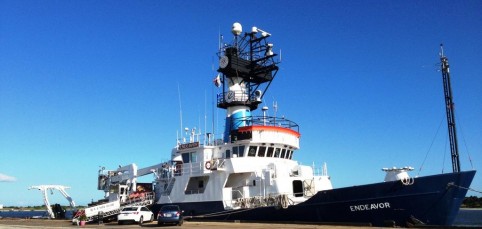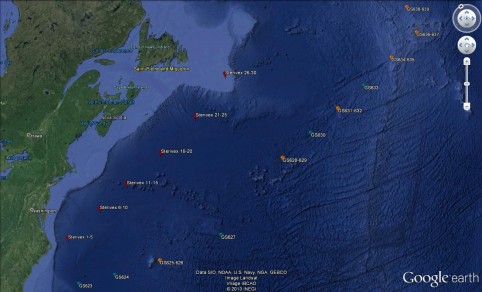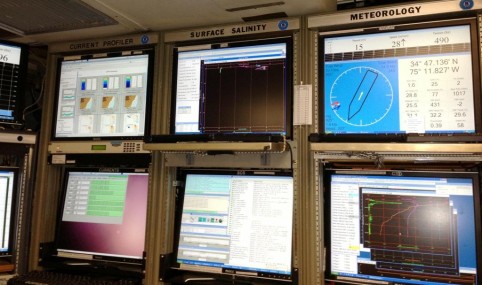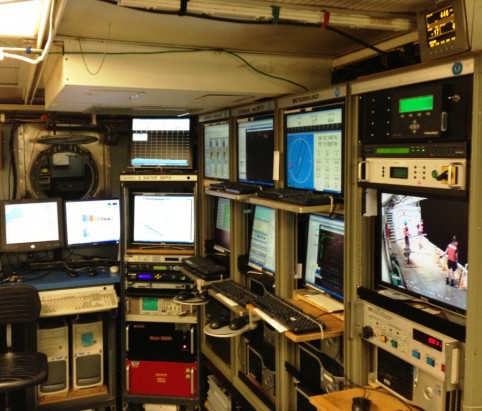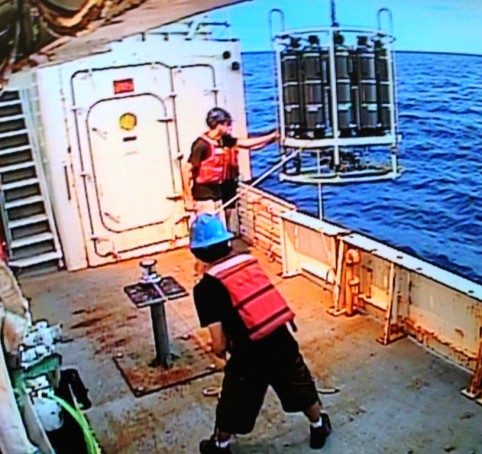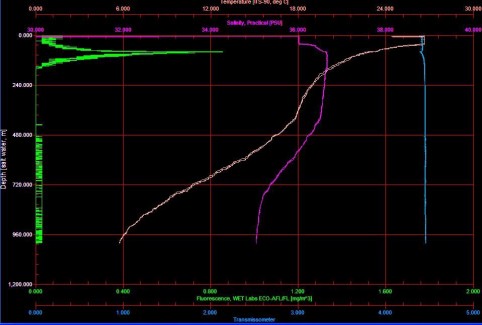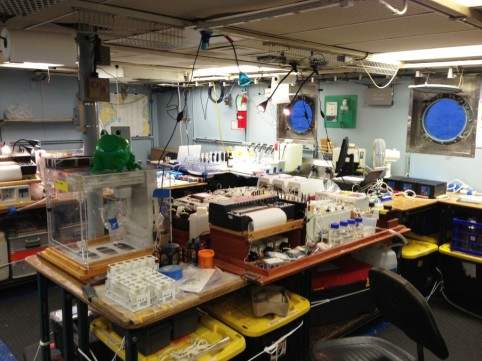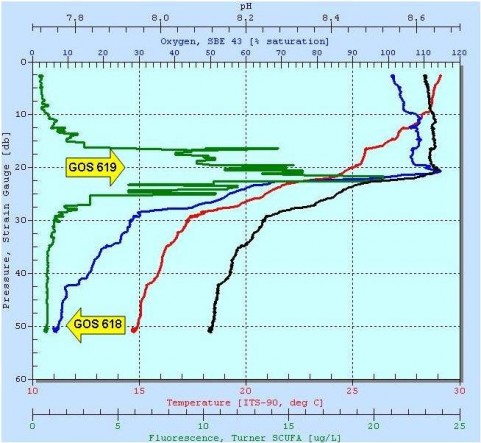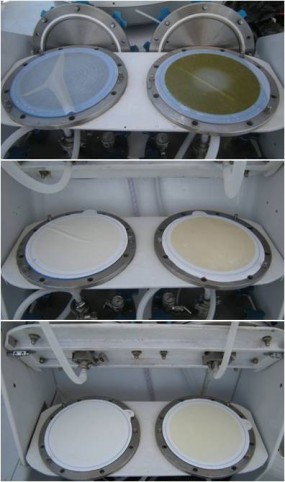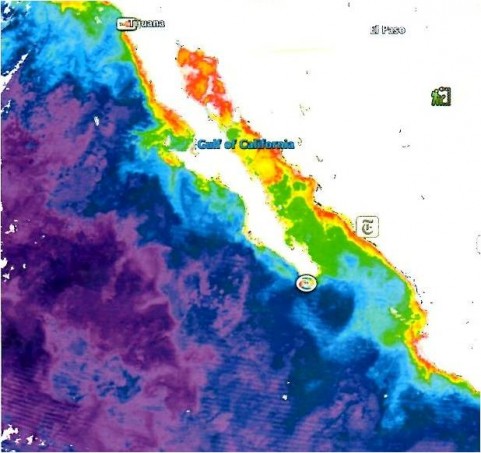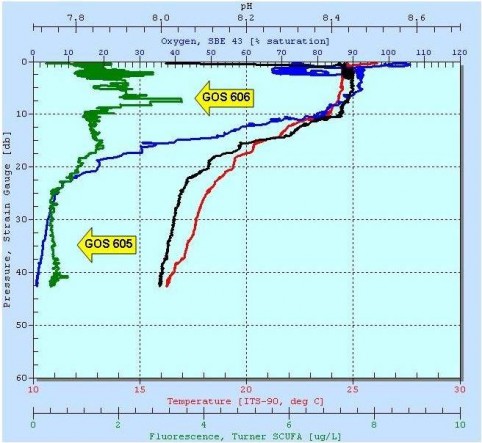I’m off again on an ocean sampling voyage but this time instead of being onboard the JCVI’s Sorcerer II, I am onboard the R/V Endeavor as part of a multi-institution, international scientific sampling team that is headed from the US to the Azores.
On Thursday August 22 we left Morehead City, North Carolina for Ponta Delgada on Sao Miguel Island in the Azores. The research vessel will take multiple samples along the 23 day transect. Here is a rundown of the teams and the science we are conducting.
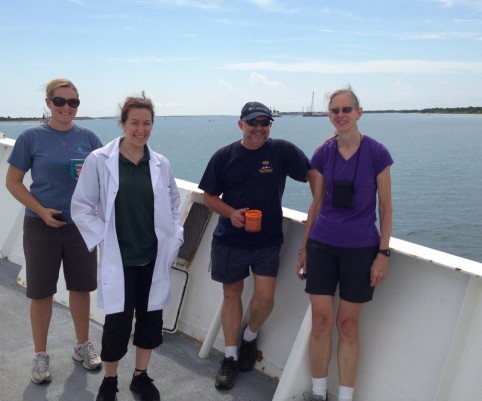
Crew leaving Morehead City, NC. From the left: Sarah Fawcett, Amandine Sabadel, Malcolm Woodward, and Bess Ward.
I will be filtering large volumes of seawater on 293mm filters for DNA sequencing, as well as smaller volumes onto smaller Sterivex filters for RNA sequencing and associated studies of gene expression within various microbial communities. This research expedition is funded by a grant from the National Science Foundation program in Dimensions of Biodiversity to Bess Ward at Princeton University and Andrew Allen at JCVI. The goal of our JCVI group is to extend findings from the Sorcerer II Global Ocean Sampling program, which documented massive genomic diversity and unusual physiological and biochemical capabilities within and between many lineages of marine microorganism. With samples collected on this research cruise, we will have the opportunity to document large-scale patterns in gene expression, and generate key hypotheses related to the most biochemically-active microbes across a major section of the upper 1000m of the North Atlantic. Data obtained from this study will be combined with similar data we collected last February and August on cruises out of Bermuda to the Bermuda Atlantic Time Series (BATS) stations in the in the sub-tropical Atlantic.
The Princeton team headed up by Bess Ward includes Sarah Fawcett, Nicolas Van Oostende, Jess Lueders-Dumont, Dario Marconi, and Keiran Swart. Their primary research involves using flow cytometry to physically capture, size fractionate and identify microbes living in the sunlit layer of the ocean. These microbes are directly responsible for assimilation of dissolved nitrate, which accumulates in the dark interior of the ocean. Specific identification of these microbes is an important research goal for microbial oceanography because the regulation and magnitude of global oceanic CO2 assimilation is driven explicitly by nitrate assimilation by photosynthetic microbes. Such microorganisms also produce a large fraction of the oxygen in the atmosphere. The Princeton group will perform nitrification experiments and measure levels of dissolved nitrate, ammonia and carbon by using stable and natural isotope tracers. The team will investigate the origins of dissolved inorganic nitrogen by measuring the natural abundance of the nitrogen isotopes. Net tows will also be performed to collect the “bigger” planktonic organisms, such as zooplankton, within the ocean food chain.
Real time nutrient data down to nanomolar levels will be determined by Malcolm Woodward of Plymouth Marine Laboratory (PML) and Amandine Sabadel from the University of Otago in New Zealand.
As we motor to our first station, which we should reach on Monday September 2nd, we stop every morning at 5 am to perform a CTD cast to 1000 meters. Based on biological and physical features, observable in real time via CTD sensors cabled to the shipboard computer,12 bottles, each containing 30 liters of sea water, are sealed at varied depths and the 360 liters is brought to the boats deck. Once the CTD is on the deck, the different scientists scurry to gather their allocated amount of water from the CTD rosette and hurry back to their labs to do the appropriate work.
As of Wednesday August 28, 2013, we have done 7 transect CTD casts, all but one to 1000 meters. Today we sampled on the Grand Banks and the water column depth was only 57 meters. For every cast I have collected RNA samples at 1000 meters, 250 meters, within the Deep Chlorophyll Max (DCM) (if no DCM is apparent, then just below the Chlorophyll max), a sample from within the Chlorophyll max and in the mixed layer (normally at 20 meters).
The weather has been great except for one 24 hour period when the swells grew to about 7 feet and the boat was really rolling back and forth. The crew is great, the food is awesome, good thing they have a small gym or I don’t think most of us would fit in our clothes after a few weeks out here! The scientists are working well as a team and this should be a very exciting and beneficial science expedition.
Once we get to the our first station we will stay there for two days………….it will be a very intense two days, then a day motor to the second station followed by another crazy two days of sampling………….more on that next blog!

